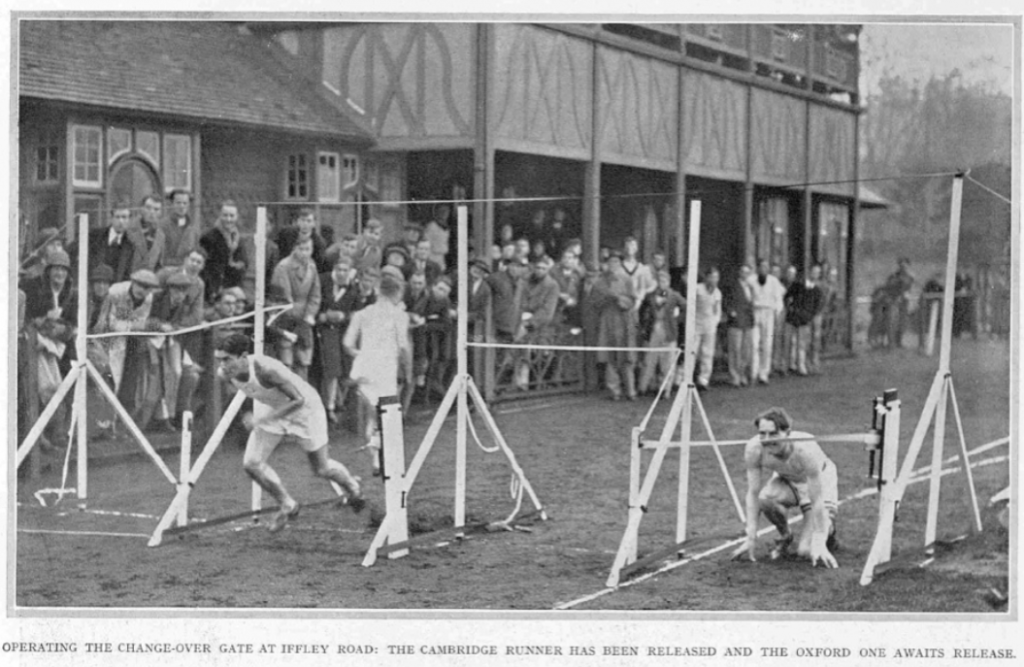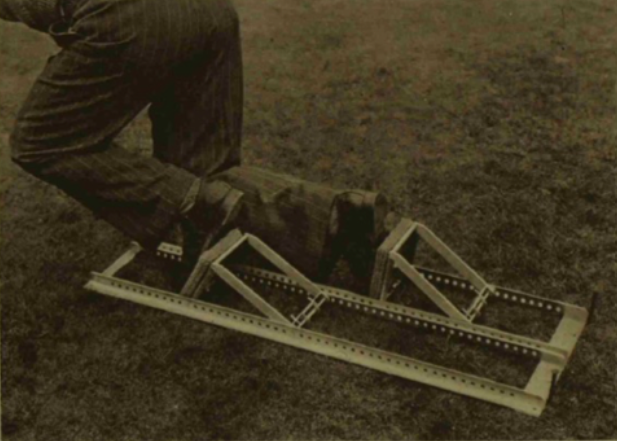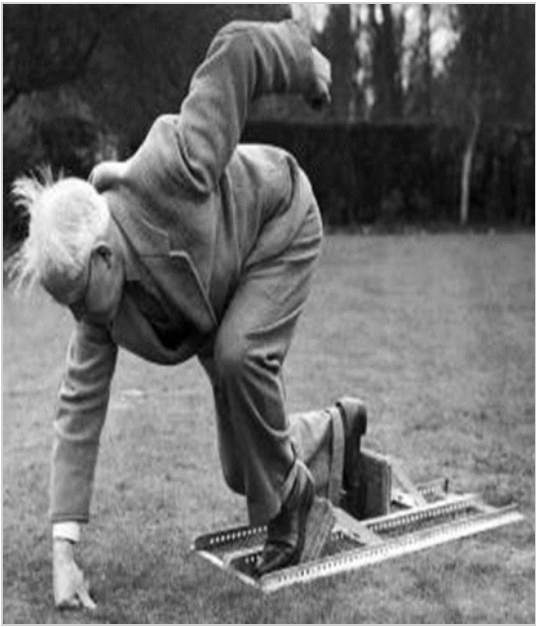I can remember when I started in the sport that the local club starting blocks were made in the local factory as a private enterprise. They came in sets of two adjustable blocks with a carpet covered foot plate, and four spikes to be slotted through holes in the bottom of the block which were hammered hammered into the track. Each block was fixed to the track separately, the whole process taking some time to complete. It did not take the experts long to bring forward blocks fixed to a central column which speeded up the setting of the blocks. But how did we get to the place where starting blocks were developed at all, never mind to the sophisticated starting aids we have now? Tom McNab gives us a brief history of sprint starts through the centuries.
HUSPLEX TO STARTING BLOCKS
I recently posed a good friend of mine, a fine sprints coach, a few questions on his event. When, I asked him, was the crouch start invented? He was about twenty years out, and no wiser about the date of the invention of the starting block.
Before answering either of these pressing questions, let me say that I believe that any coach with a passion for his event should immerse himself in it. For that interest should surely travel far beyond the most recent Powerpoint presentation or the latest drills, and involve at least a passing interest in the history of his event. Perhaps that is just the opinion of an old fogey, but that’s the way I feel.
The crouch start was invented around 1885 by the Irish-American coach Mike Murphy ( father of the film star George Murphy), and presented a year later on May 12th at the Rockaway track to a bewildered starter by the sprinter Charles Sherrill, who was advised by him to adopt a proper position. I have the photograph to hand as I write. There are three other sprinters, all adopting various versions of the standing start. These were the ”lunge”,( a half-twist), a basic standing start, and the “dab” start, which meant that the front foot came down first. And then there is our man Sherrill, knuckles on the ground, toe on the line and wearing a woollen hat, with left knee way out of line.
By the first Olympics of 1896, the crouch start had begun to establish itself, but even in the 100m. final only one runner adopted it. Another had a semi-crouch, supported on high pegs, the rest simply stood.
There was little in the way of technical development of the crouch start in the next forty years, when the starting block was invented. But I am getting ahead of myself. For the Greeks had invented a starting-sill, with grooves set a few inches apart in the stone sill. And they had also invented a starting-gate, the husplex. This was a right -angled gate, with the runner behind a horizontal wooden slat, held so by a string which passed down the vertical post into grooves on the sill, back to the starter, who held the strings for each husplex. When he dropped the strings, the horizontal slats fell, allowing the runners to surge forward.
What happened before the husplex? Simple. False starters were whipped. I have put this idea to the Technical Committee of the IAAF, but have so far received no reply.
Husplex being used at a relay changeover
The modern starting block was invented by the American George T. Bresnahan in 1927, was called “the G.T. Bresnahan Foot Support”, and given Patent Number 1701026 on April 29th, 1927. Within a year George Simpson had run 9.4 for 100 yards using them, a time which was not accepted as a world record.
By the 1948 Olympics starting – blocks were accepted. I remember them well, heavy cumbersome things, with coconut matting to cover the block- surface. The 1980 Games saw the introduction of pressure-sensitive starting- blocks.
So there we are, from husplex to starting- blocks, but that isn’t all. For what happened before the starting gun? In rural sports, starts were made using a drum or even a trumpet. In betting-based two man match-races, starts were “by consent”. This meant that they were rather like a Western gunfight, the only difference being that if one runner was unhappy, then the whole process had to be repeated. This led by the middle of the 19th century in contracts insisting on a gun-start if consent was not secured within a given time, and soon consent had virtually vanished. By the 1860s match-races had begun to fall out of favour, and handicap-based “Pedestrian Carnivals” began to dominate, making consent impossible.
So we are at end of this particular story, from husplex to starting- blocks, from “consent” to gun, from the “dab” start to the crouch. Perhaps it doesn’t matter, what happened in the distant past, but there is a saying that those who know nothing of the past are lost in the present.
But our governing body clearly thinks that the past is of some importance, for in a high jump instructional poster it states that the Greeks “probably” practiced high jump. No ,they did not. And that women first competed in Olympic athletics in Paris in 1924. No, it was 1928, in Amsterdam. But what does it matter?
Lastly, sprinters had traditionally made their own rudimentary starting blocks, but when it was announced that the London Games in 1948 would allow such aids for the first time, Rottenburg came up with adjustable blocks and a system to anchor the mechanism to the track.
Born in Glasgow, Rottenburg attended Kelvinside Academy and Loretto School, before studying mechanical science at King’s College, Cambridge, where he was a varsity rugby fullback. He also played for representative matches with Middlesex and was capped five times for Scotland, which included regaining the Calcutta Cup from England in 1899. After a spell in America, Rottenburg returned to Cambridge in 1904 and lectured in electrical engineering. He was involved in athletics as a measurement official for the Amateur Athletic Association and is crediting with inventing the modern starting blocks, having come up with the original design of blocks that were adjustable and anchored to the track.
The story of Rottenburg and the starting blocks can be found at:
Rottenburgh testing his blocks,



